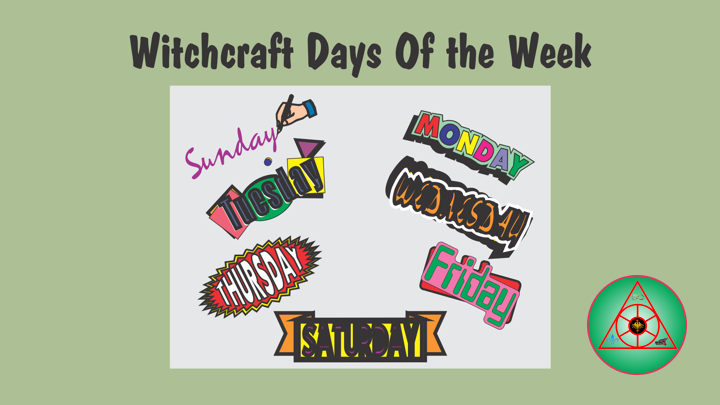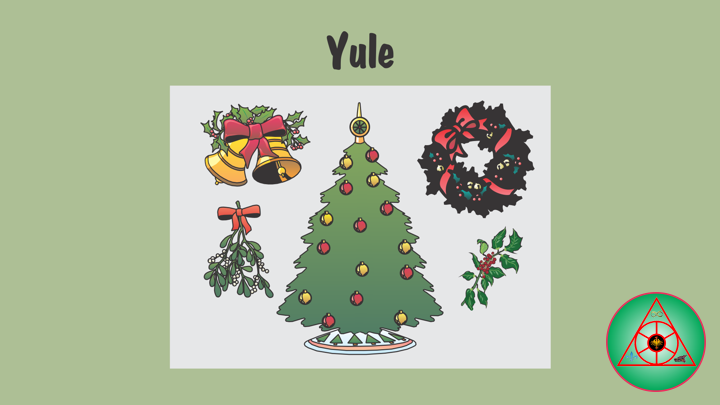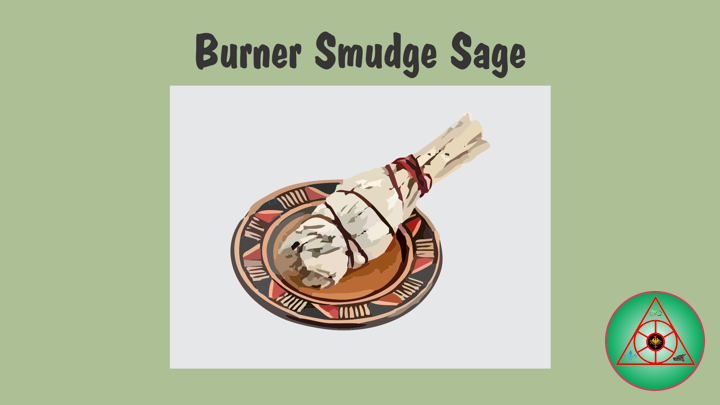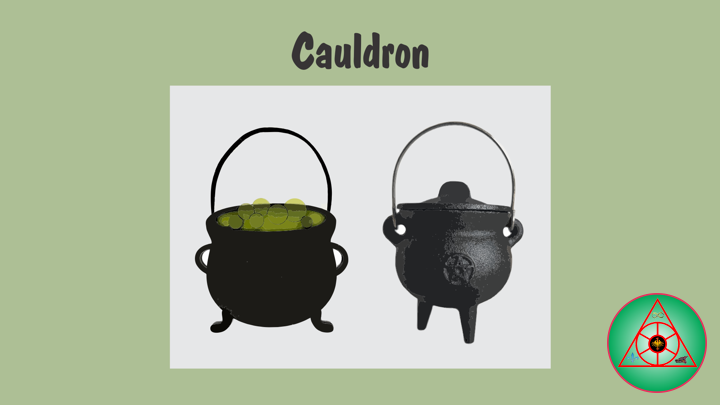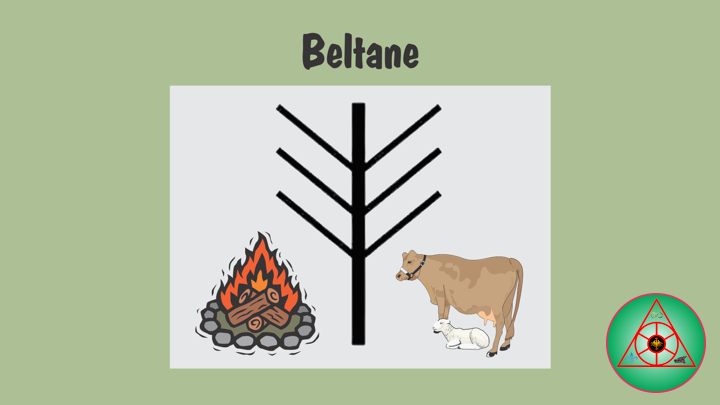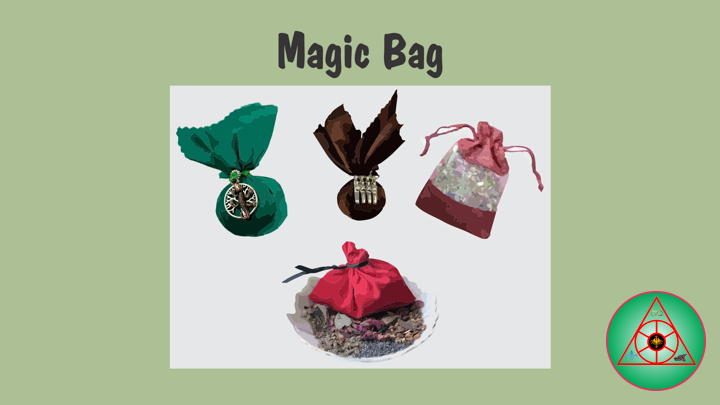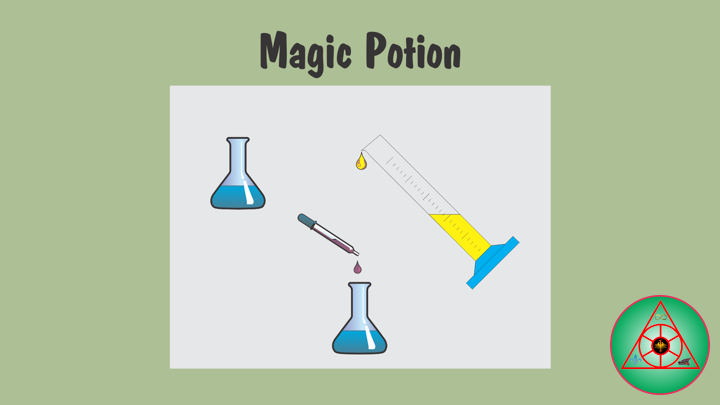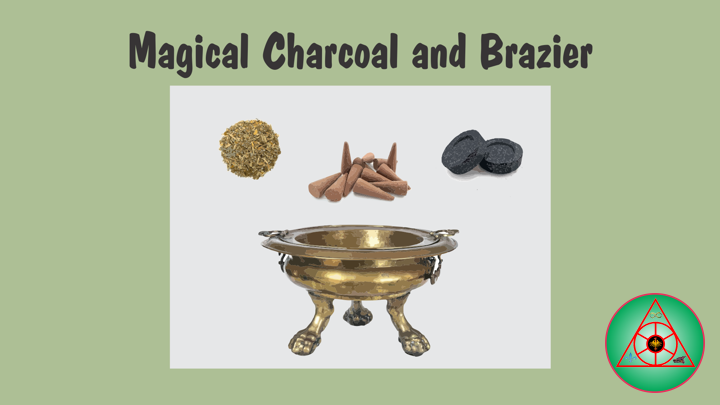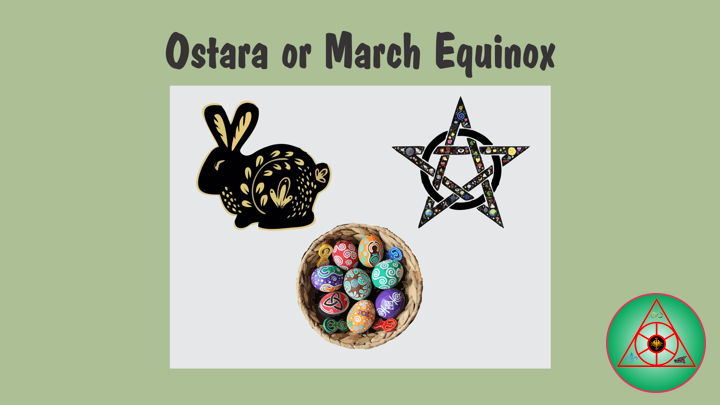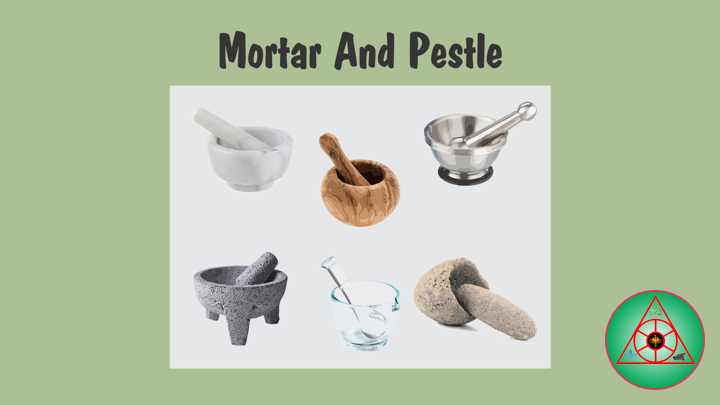Herb, Oil…
Herb, Oil…
——
#Magic #TLBWB #HighPriestess #Witchcraft #Wizard #Witch #WitchcraftDaysWeek #BookOfShadows #WheelOfTheYear #MagicalHerbs #MagicalOils #Incense #Pentacle #MagicCircle #MagicSpell #Grimoire
——
——
Witchcraft Days Of the Week
In many traditions of Witchcraft, days of the week are important aspects of effective spellcasting. While not all traditions follow this rule, when you’re doing any magical working, always be sure to document the day of the week you’re performing the spell. You might be surprised later on to see some connections.
Sunday
Sunday is associated with the colors yellow and gold, which shouldn’t be surprising, it’s the day of the sun. When it comes to crystal use, Sunday is related to quartz crystals and diamonds, as well as the yellowish hues of carnelian and amber. For herbs and plants in magical workings, use marigolds, sunflowers, or cinnamon.
What kind of magic is best performed on Sunday? Well, it’s a day that generally has many associations agriculture, beauty, hope, victory, self-expression, and creativity are all connected to this particular day. Plant or harvest something new, create something from nothing and prepare to win at everything.
Monday
Monday is the day of the moon itself, and it’s a day that’s connected to lunar colors like silver, white, or even a pale blue. Metals and gemstones like silver, pearl, opal, and moonstone all come into play today. Utilize wintergreen or peppermint, as well as catnip, comfrey, sage, and chamomile in your workings.
When it comes to Monday magic, because of that lunar connection, it’s a good time to focus on workings related to childbearing and family life, purity and virginity, healing, wisdom, and intuition. Do a little bit of self-exploration and work on developing your intuition, learn to trust your gut. Celebrate birth and life, and make some magic to fix what is broken.
Tuesday
Tuesday is a very martial sort of day color associations include bright red and oranges, as well as warrior, like metals such as iron and steel. Red gemstones like rubies and garnets come into play on Tuesdays, as do herbs and plants such as thistles, holly, coneflowers, and cacti, you’ll notice these are all sharp, prickly plants.
One of the interesting and more than a little amusing aspects of Tuesday magic is that in addition to war and conflict against your enemies, this is a day also associated with marriage. You can also use this day of the week for magical workings connected to protection and initiation. Use Tuesday to assert yourself, make a mark and stake your claims.
Wednesday
This is a day associated with the color purple, the planet Mercury, and the metal quicksilver which is also called mercury. Gemstones like adventurine and agate come in handy as well, as do plants such as aspen trees, lilies, lavender, and even ferns.
Business and job related issues, communication, loss and debt, traveling, and journeys are all tied into Wednesday. This is a good day to do a working to open up lines of communication, especially if your actions are preventing you from being an effective speaker or listener. Go someplace new or return to an old favorite stomping ground, step up your game, and settle up your accounts.
Thursday
Thursday is a day of royal blues and greens, associated with the planet Jupiter and metals like tin. Gemstone correspondences for Thursday include turquoise, amethyst and lapis lazuli, and plant associations can be found in honeysuckle, cinquefoil, and even oak trees.
This is a day for honor, fealty and family loyalty, as well as harvesting, success, and prosperity. Take advantage of Thursday’s different aspects and do spellwork that brings abundance to you, declares your allegiance, and embraces prosperity.
Friday
Friday falls at the end of the work week for many of us, and that means we get a chance to relax for a little bit. Mark your Fridays with colors like pink and aqua, and metals such as copper. Gemstones associated with Friday include coral, emerald and rose quartz, and plants like strawberries, apple blossoms and feverfew are also related. This is a good day to do spellwork associated with family life and fertility, sexuality, harmony, friendship, growth. Take advantage of Friday’s correspondences and plant a seed, make something grow, and enjoy your blessings.
Saturday
It’s the end of the week for many of us, so Saturday is a good time to wrap things up. Associated with the colors black and dark purple, and the metal lead. Gemstones like Apache tear, obsidian, and hematite are all connected to Saturday’s magic, as are plants such as thyme, mullein, and the cypress tree.
When it comes to magical workings, focus on agriculture and creativity, fortune and hope, protection and banishment of negativity. Put up a barrier to keep the unwelcome out, eliminate the things that make you miserable, and wash your hands of anything other than your hopes, dreams, and goals.
Follow Us
Languages Spoken and Written: English, French and Spanish.
eMail: lostbeardedwhite@sassquatch.org
Facebook: https://www.facebook.com/neosteam.labs.9/
YouTube: https://www.youtube.com/@thesass2063
Twitter: https://twitter.com/labs_steam
Pinterest: https://www.pinterest.com/NeoSteamLabs/
Instagram: https://www.instagram.com/luc.paquin/
The Lost Bearded White Brother
——
#Magic #TLBWB #HighPriestess #Witchcraft #Wizard #Witch #Yule #BookOfShadows #WheelOfTheYear #MagicalHerbs #MagicalOils #Incense #Pentacle #MagicCircle #MagicSpell #Grimoire
——
——
Yule
The Winter Solstice is a solar holiday that occurs on December 21 or 22 in the Northern Hemisphere. During this time, the earth’s axis is tilted farthest away from the sun, creating the longest night of the year. The Winter Solstice is celebrated across many pagan traditions, honoring the sun and the halfway point of winter.
Yule was originally celebrated by the Norse and Scandinavian peoples. Depending upon the source, Yule was celebrated as a two month celebration beginning mid-November, a 12 day celebration starting on the Solstice, or a three day feast beginning on the eve of the Winter Solstice. Today, many Pagans still celebrate Yule on the day of the Winter Solstice. Pagans celebrate the rebirth of the sun through gift exchanges, merriment, and deep spiritual reflection. For Pagans, this is a time of new beginnings, rebirth, transformation, getting rid of unwanted habits, and creativity. The symbols of Yule are evergreens, the Yule Log, a Yule tree, mistletoe, holly, wreaths, and bells. The colors of Yule are white, green, red, gold, and silver.
Evergreens are popular decorations during Yule because they remind us that life continues through the cold and dark winter. Traditions of decorating with evergreens date back to many ancient civilizations, including the Romans. Today, Pagans decorate a pine, fir, cedar, juniper, or spruce as their Yule tree. One way to celebrate Yule is to craft a magical ornament to hang on your Yule tree.
Seasonal plants are an integral part of Yule. The custom of setting up an evergreen tree is an old tradition of bringing the outdoors in. Evergreens symbolize the continuation of life, as they remain full and bright while all the other trees lose their leaves. Boughs and garlands collected from evergreen trees can be used to decorate indoor spaces.
Holly represents the old solar year as well as the Holly King, who may have been a precursor to Santa Claus. It was once considered a sacred plant by the Druids, and was a symbol for protection. Ivy is another reminder that life continues, as the plant often lives on after its host plant has died. It is said to represent fidelity and loyalty. Hanging ivy around the house during this time of year is a way to symbolize the strength of family bonds. Well-known for its association with December holidays, mistletoe stands for peacemaking and the end of discord. It’s said that the Norsemen laid down their arms if they met underneath a growth of mistletoe. Birch is another plant that is associated with rebirth, as it’s often the first tree to grow back in a forest that has burned.
As contemporary pagan religions differ in both origin and practice, these representations of Yule can vary considerably despite the shared name. Some Heathens, for example, celebrate in a way as close as possible to how they believe ancient Germanic pagans observed the tradition, while others observe the holiday with rituals assembled from different sources. Heathen celebrations of Yule can also include sharing a meal and gift-giving.
In most forms of Witchcraft, this holiday is celebrated at the winter solstice as the rebirth of the Great horned hunter god, who is viewed as the newborn solstice sun. The method of gathering for this sabbat varies by practitioner. Some have private ceremonies at home, while others do so with their covens:
This dark and quiet time of the winter season is an opportunity to focus on new beginnings. It’s a time to incorporate nature into your home, practice gratitude for abundance, and celebrate the returning of the light. Decorating the house with greenery and lighting candles are important ways to incorporate this holiday into your home.
Celebrate Yule include:
- Setting up a Yule altar.
- Reciting prayers to welcome back the sun.
- Performing cleansing rituals and tree blessings.
- Smoke purification. Burning seasonal plants like pine, cedar, rosemary, juniper, and frankincense can cleanse the home and provide delightful holiday aromas.
- Sending Yule greeting cards.
- Holding a Yule log ceremony. The old tradition of holding a Yule log ceremony is a way to welcome back the sun. A log can be used first as a Yule altar, decorated with candles and evergreen boughs, before it’s burned on the evening of the winter solstice.
- Feasting!
It’s a great time to enjoy the process of cooking large meals to share with family and friends. Specific courses for Yule include plum pudding, mulled apple cider, and hot buttered rum. Of course, the classic Bûche De Noël is a cake that represents the Yule log.
Follow Us
Languages Spoken and Written: English, French and Spanish.
eMail: lostbeardedwhite@sassquatch.org
Facebook: https://www.facebook.com/neosteam.labs.9/
YouTube: https://www.youtube.com/@thesass2063
Twitter: https://twitter.com/labs_steam
Pinterest: https://www.pinterest.com/NeoSteamLabs/
Instagram: https://www.instagram.com/luc.paquin/
High Priestess Natalie
——
#Magic #TLBWB #HighPriest #Witchcraft #Wizard #Witch #BurnerSmudgeSage #BookOfShadows #WheelOfTheYear #MagicalHerbs #MagicalOils #Incense #Pentacle #MagicCircle #MagicSpell #Grimoire
——
——
Burner Smudge Sage
Smudging encourages us to stop, slow down, and become mindful of ourselves. When we smudge, we can connect and become grounded. Smudging can help us feel calm and safe and allows us to let go of negative feelings and thoughts. The term has been used to refer to the Smudging ceremonies of a wide variety of Indigenous peoples, although not all Indigenous peoples refer to the act as Smudging. During these ceremonies, sacred herbs and medicines are burned for cleansing. Many other cultures around the world share similar rituals.
Burning Smudge Sage, also known as cleansing is an ancient spiritual ritual. Certain types of sage have antimicrobial properties, to improve your overall well-being, and may provide additional benefits. It may be purifying this means they keep infectious bacteria, viruses, and fungi at bay. Smudge Sage Burning is thought to release negative ions.
Burning Smudge Sage has long been used to connect to the spiritual realm or enhance intuition. For healers and laypeople in traditional cultures, Burning Smudge Sage is used to achieve a healing state, or to solve or reflect upon spiritual dilemmas. Research shows that thujone is mildly psychoactive. It’s actually found in many plants used in cultural spiritual rituals to enhance intuition.
Burning Smudge Sage may also be used as a ritual tool to rid yourself, or your space, of negativity. This includes past traumas, bad experiences, or negative energies from others. This may help you establish a positive environment for meditation or another ritual. Choosing to sit and let go of negative thoughts in a ritual like this sets your intention and dedication to self-improvement. Choosing to engage in ritual can be the beginning of your change in mindset.
It may help improve your mood, tradition suggests that Burning Smudge Sage can literally lift one’s spirits to banish negativity. If Burning Smudge Sage can lift one’s mood, it could also be a great ally against stress. Burning Smudge Sage has been traditionally used to safeguard against negativity that could interfere with sleep. In addition to dissipating negative energy, improving mood, and strengthening intuition, burning sage might improve your memory and focus. For some, this may be the best of all benefits: Sage is a lovely incense with a divine aroma, pure and simple.
Follow Us
Languages Spoken and Written: English, French and Spanish.
eMail: lostbeardedwhite@sassquatch.org
Facebook: https://www.facebook.com/neosteam.labs.9/
YouTube: https://www.youtube.com/@thesass2063
Twitter: https://twitter.com/labs_steam
Pinterest: https://www.pinterest.com/NeoSteamLabs/
Instagram: https://www.instagram.com/luc.paquin/
The Lost Bearded White Brother
——
#Magic #TLBWB #HighPriest #Witchcraft #Wizard #Witch #Cauldron #BookOfShadows #WheelOfTheYear #MagicalHerbs #MagicalOils #Incense #Pentacle #MagicCircle #MagicSpell #Grimoire
——
——
Cauldron
A cauldron is a large pot for cooking or boiling over an open fire, with a lid and frequently with an arc-shaped hanger or integral handles or feet. There is a rich history of cauldron lore in religion, mythology, and folklore. The word cauldron is first recorded in Middle English as caudroun.
Symbolism and Mythology
Cauldrons have largely fallen out of use in the developed world as cooking vessels. While still used for practical purposes, a more common association in Western culture is the cauldron’s use in Witchcraft. In Witches often prepare their potions in a cauldron.
In some forms of Witchcraft, appropriating aspects of Celtic mythology, the cauldron is associated with the goddess Cerridwen. In Witchcraft and some other forms of neopagan or pagan belief systems, the cauldron is still used in magical practices. Most often a cauldron is made of cast iron and is used to burn loose incense on a charcoal disc, to make black salt, for mixing herbs, or to burn petitions. Cauldrons symbolize not only the Goddess but also represent the womb and on an altar, it represents earth because it is a working tool.
No surprise, cauldrons started out as a cooking tool. Warm soups and stews were concocted in them to give nourishment to families. They were the heart of the home and life-giving in cold seasons. As cauldrons became more commonplace and important to families, mothers and grandmothers started using them for healing herbal blends and eventually potions.
After being used for centuries as a cooking and healing tool, cauldrons started to take on more sacred and magical meanings. The cauldron began to represent the Goddess, the Sacred Divine, and a vessel for transformation, healing, and abundance.
Represent the Four Elements on Your Altar
- Earth: The iron the cauldron is made out of represents earth.
- Water: The water used while cooking in a cauldron represents the water.
- Fire: A cauldron would traditionally be heated from a fire underneath it which represents fire.
- Air: The air around and blow on the soup or potion inside represents the air.
The elements are purely symbolic for this use, no need to always have a fire burning underneath your cauldron. You can read more about the four elements here. There are several rituals that call for fire and burning. Whether it’s incense, candles, or burning a piece of paper, a cauldron will not only serve as a sacred tool but will also give you a safe tool for ritual fires. Here are a few ways to use your cauldron for any fire-related rituals.
Follow Us
Languages Spoken and Written: English, French and Spanish.
eMail: lostbeardedwhite@sassquatch.org
Facebook: https://www.facebook.com/neosteam.labs.9/
YouTube: https://www.youtube.com/@thesass2063
Twitter: https://twitter.com/labs_steam
Pinterest: https://www.pinterest.com/NeoSteamLabs/
Instagram: https://www.instagram.com/luc.paquin/
The Lost Bearded White Brother
——
#Magic #TLBWB #HighPriest #Witchcraft #Wizard #Witch #Beltane #BookOfShadows #WheelOfTheYear #MagicalHerbs #MagicalOils #Incense #Pentacle #MagicCircle #MagicSpell #Grimoire
——
——
Beltane
Beltane May Day festival. Commonly observed on the first of May, the festival falls midway between the spring equinox and summer solstice in the northern hemisphere. The word “Beltane” roughly translates as “Bright Fire” and, as such, one of the most important rituals, which survives today in our modern festival, concerns the lighting of the Beltane bonfire. Fire was seen as a purifier and healer and would have been walked around and danced, jumped over by the members of the community. Farmers would also have driven their cattle between bonfires to cleanse and protect them before being put out into the fields. It marked the beginning of summer and was when cattle were driven out to the summer pastures.
Rituals were performed to protect cattle, people and crops, and to encourage growth. Special bonfires were kindled, whose flames, smoke and ashes were deemed to have protective powers. The people and their cattle would walk around or between bonfires, and sometimes leap over the flames or embers. All household fires would be doused and then re-lit from the Beltane bonfire. These gatherings would be accompanied by a feast, and some of the food and drink would be offered to the Beltane. Doors, windows, byres and livestock would be decorated with yellow May flowers, perhaps because they evoked fire.
In ancient communities, all hearth fires would have been extinguished and a new neid fire lit which would have then been used to relight people’s hearths in their own homes. In this way the community was connected to each other by the sacred fire which was central to all. The festival would also have been a time of courtship rituals and a celebration of our own fertility.
The important point to note when thinking about our own festival is the joy and the revelry that is fostered in the ritual. It is about casting off the darkness and celebrating the light. It is a time for celebrating fertility, both in the context of our biological functions as well as our own creative energies, the fertility of our creative community.
Yellow and white flowers such as primrose, rowan, hawthorn, gorse, hazel, and marsh marigold were traditionally placed at doorways and windows. Sometimes loose flowers were strewn at doors and windows and sometimes they were made into bouquets, garlands or crosses and fastened to them. They would also be fastened to cows and equipment for milking and butter making. It is likely that such flowers were used because they evoked fire. Similar May Day customs are found across Europe.
Beltane Rituals
- Fire: Go outside and safely have a bonfire with friends. Bring fresh foods from local gardens to eat over the flames and give thanks to your community by bringing them together.
- Create A Fairy Altar: The veil is thin during Beltane and creatures from the other realms often visit. Create a small altar for them when they visit, fill it with colorful flowers, ripe smells and sweet tasting food.
- Create Flower Crowns: The season is bursting with flowers, why not adorn yourself and your family with them too. Weave together long grasses and stems with flowers and sing songs throughout your neighborhood.
- Maypole: This can be done on a small and large scale. Wooden dowels work amazing for every person to craft their own maypole with flowers and ribbon. They also make great garden ornaments when you’re done.
- Cast A Spell: Beltane is rich with magic, especially for fertility and love. Write your intention or wish on a piece of paper and blow it into the wind, or sing it out and let the wind carry your words out into the universe.
- Moon Phases: Couples, if you and your significant other are long-term partners, this is a time of renewal and rededication of devotion.
Follow Us
Languages Spoken and Written: English, French and Spanish.
eMail: lostbeardedwhite@sassquatch.org
Facebook: https://www.facebook.com/neosteam.labs.9/
YouTube: https://www.youtube.com/@thesass2063
Twitter: https://twitter.com/labs_steam
Pinterest: https://www.pinterest.com/NeoSteamLabs/
Instagram: https://www.instagram.com/luc.paquin/
The Lost Bearded White Brother
——
#Magic #TLBWB #HighPriest #Witchcraft #Wizard #Witch #MagicBag #BookOfShadows #WheelOfTheYear #MagicalHerbs #MagicalOils #Incense #Pentacle #MagicCircle #MagicSpell #Grimoire
——
——
Magic Bag
Magic Bag is an amulet consisting of a flannel bag containing one or more magical items. It is a “Prayer In A Bag”, or a spell that can be carried with or on the host’s body. The creation of Magic Bags is an esoteric system that involves sometimes housing spirits inside of bags for either protection, healing, or harm and to consult with spirits. Other times Magic Bags are created to manifest results in a person’s life such as good-luck, money or love.
Magic Bags using leather or cloth and placed feathers, animal bones, animal teeth, claws, animal parts, roots, lucky hand root, herbs, bean, ceramics, glass beads, minerals, coins, crystals, good luck tokens, amulets, lizard’s tail, rabbit’s foot, a fish eye, snake skins, a beetle and other ingredients for protection. The more personalized objects are used to add extra power because of their symbolic value. Magic Bags can be hung from trees, tied to a string, worn underneath the clothes to cause an effect on the target. Magic Bags usually made by a respected community conjure Witchcraft Doctor. Natural ingredients have their own indwelling spirit that can be utilized in Magic Bags to bring luck and protection.
Witchcraft where it is said to drive away evil spirits, keep good luck in the household, manipulate a fortune, and lure and persuade lovers. The ideology of the ancestors and the descendants of the Magic Bag used this “Prayer In A Bag” based on their belief of spiritual inheritance, by which the omniscient forefathers of their families would provide protection and favor, especially when they used the Magic Bag. Through this, a strong belief was placed in the idealism of whoever used Witchcraft, creating a spiritual trust in the magic itself.
There is a process to fixing a proper Magic Bag. A ritual must be put in place in order to successfully prepare a Magic Bag by being filled and awakened to life. This can be done by smoking incense and candles, or it may be breathed upon to bring it to life. Prayers may be said, and other methods may be used to accomplish this essential step. Once prepared, the Magic Bag is “Dressed” or “Fed” with a liquid such as alcohol, perfume, or water. The reason it is said to feed the Magic Bag to keep it working is that it is alive with spirit.
Follow Us
Languages Spoken and Written: English, French and Spanish.
eMail: lostbeardedwhite@sassquatch.org
Facebook: https://www.facebook.com/neosteam.labs.9/
YouTube: https://www.youtube.com/@thesass2063
Twitter: https://twitter.com/labs_steam
Pinterest: https://www.pinterest.com/NeoSteamLabs/
Instagram: https://www.instagram.com/luc.paquin/
The Lost Bearded White Brother
——
#Magic #TLBWB #HighPriest #Witchcraft #Wizard #Witch #MagicPotion #BookOfShadows #WheelOfTheYear #MagicalHerbs #MagicalOils #Incense #Pentacle #MagicCircle #MagicSpell #Grimoire
——
——
Magic Potion
A Magic Potion is a liquid that contains medicine, or something that is supposed to have magic powers. It derives from the Latin word potus which referred to a drink or drinking. The Magic Potion is also used, often specifically for a love potion, a potion that is supposed to create feelings of love or attraction in the one who drinks it. Throughout history there have been several types of potions for a range of purposes. Emotions such as anger, fear and sadness are universal and as such potions have been created across history and cultures in response to these human emotions. Administered in small doses Magic Potion has been used in Witchcraft as an analgesic, an aphrodisiac and a remedy for infertility. Reasons for taking potions ranged from curing an illness, or love, or health care, or restorative, or hallucinogenic, Etc…
Considering that these practices align more with cultural views and beliefs, many of these individuals used Magic Potion and traditional medicine or alternative medicine. Magic Potions, in addition to calming teas or soup, were a common homemade treatment. When unable to go to a house member, early modern people would often go to the wise men or women of their village. Wise Wizard or Witch were knowledgeable in health care and could administer potions, lotions or salves in addition to performing prayers or chants.
So, let’s talk Magic Potion. Whether you think of them as mysterious plants that grow in the forest or the row of little bottles in your kitchen cabinet, they’re pretty useful, and they can be pretty confusing, even intimidating. What do you do with them? Which ones do I need? These Magic Potion will help you with almost any need or problem you may have, as we shall explain. If you’re a practitioner of a modern magical tradition, chances are good that you’re in the habit of using Magic Potion. Magic Potion; MagicalHerbs or Magical Oils plants in the form of oil and incense were elements of religious and therapeutic practices in early cultures worldwide. In addition, anointment with perfumes and fragrant oils was an almost universal practice.
Follow Us
Languages Spoken and Written: English, French and Spanish.
eMail: lostbeardedwhite@sassquatch.org
Facebook: https://www.facebook.com/neosteam.labs.9/
YouTube: https://www.youtube.com/@thesass2063
Twitter: https://twitter.com/labs_steam
Pinterest: https://www.pinterest.com/NeoSteamLabs/
Instagram: https://www.instagram.com/luc.paquin/
The Lost Bearded White Brother
——
#Magic #TLBWB #HighPriest #Witchcraft #Wizard #Witch #MagicalCharcoal #Brazier #BookOfShadows #WheelOfTheYear #MagicalHerbs #MagicalOils #Incense #Pentacle #MagicCircle #MagicSpell #Grimoire
——
——
Magical Charcoal
Charcoal is a lightweight black carbon residue produced by strongly heating wood or other plant materials in minimal oxygen to remove all water and volatile constituents. In the traditional version of this pyrolysis process, called charcoal burning, often by forming a charcoal kiln, the heat is supplied by burning part of the starting material itself, with a limited supply of oxygen. Japanese charcoal has had pyroligneous acid removed during the charcoal making, it therefore produces almost no smell or smoke when burned. Natural Charcoals carefully made from compressed coconut shells. Magical charcoal are odorless and tasteless.
Magical Charcoal is used in food to colour it black and for its supposed health benefits. Activated charcoal, typically made from bamboo or coconut shell, is used as a food ingredient. It gives food an earthy, smoky taste and the black colouring gives the food an exotic, fashionable appearance.
Magical Charcoal for use with Magical Herbs for Ritual, Spells and Incense Making.
Brazier
A brazier is a container used to burn charcoal or other solid fuel for cooking, heating or cultural rituals. It often takes the form of a metal box or bowl with feet. Its elevation helps circulate air, feeding oxygen to the fire. While a fire burns in this brass brazier, you can use an action to speak the brazier’s command word and summon a fire elemental, as if you had cast the conjure elemental Magical Herbs for Ritual, Spells and Incense.
The essence burner is inspired by classic shapes of ancient braziers. Line is marked by a simple hemispherical bowl supported by three legs that form of scrolls. In the midst of these three should be placed at the Magical Charcoal as a real fire in miniature. The effect that comes out is fascinating. The smoke rising from the brazier making it seem almost magical. Its use is very old and ranged from more normal domestic use up to those religious ritual object or as a votive gift gives a further fascinating and magical energy. Suitable also as witchcraft Magical Herbs for Ritual, Spells and Incense.
Follow Us
Languages Spoken and Written: English, French and Spanish.
eMail: lostbeardedwhite@sassquatch.org
Facebook: https://www.facebook.com/neosteam.labs.9/
YouTube: https://www.youtube.com/@thesass2063
Twitter: https://twitter.com/labs_steam
Pinterest: https://www.pinterest.com/NeoSteamLabs/
Instagram: https://www.instagram.com/luc.paquin/
The Lost Bearded White Brother
——
#Magic #TLBWB #HighPriest #Witchcraft #Wizard #Witch #Ostara #MarchEquinox #BookOfShadows #WheelOfTheYear #MagicalHerbs #MagicalOils #Incense #Pentacle #MagicCircle #MagicSpell #Grimoire
——
——
March Equinox
The March Equinox is the equinox on the Earth when the subsolar point appears to leave the Southern Hemisphere and cross the celestial equator, heading northward as seen from Earth. In astronomy, the March Equinox is the zero point of sidereal time and, consequently, right ascension. It also serves as a reference for calendars and celebrations in many cultures and religions.
Ostara
Chances are, you come across some stories that the presenters claim are ancient, and reach into the pre-Christian past. One popular story you might have seen recently involves the origin of the Easter Bunny. Essentially, the tale is that Ostara, the ancient Germanic goddess of the spring, transformed a bird into a hare, and the hare responded by laying colored eggs for her festival.
The celebration of spring is present in many ancient customs, across all cultures, and it seems that Witchcraft has borrowed from many of them for Ostara. Like many other spring celebrations in other cultures, Ostara symbolizes fertility, rebirth, and renewal. This time of year marked the beginning of the agricultural cycle, and farmers would start planting seeds.
Many of the symbols of Ostara have roots in other traditions, and the use of rabbits and hares is one such example. In medieval times in Europe, the March hare was seen as a fertility symbol, and a sign of spring. This species of rabbit is nocturnal most of the year, but in March, it is mating season for the animal. During mating season, March hares are seen all day long. Additionally, females of this species can get pregnant with a second litter while pregnant with their first litter. This explains why they were used as symbols for fertility.
Modern day Witchcraft might go outside to meditate and perform a simple ritual to welcome the spring. Another common way to celebrate the coming spring is to plant seeds. Some families incorporate seasonal candy, such as peeps and chocolate rabbits, with their kids to help them get in the spirit of the event.
Ostara is also a good time to freshen up your home and life. Take time to do some spring cleaning. Cleaning isn’t just limited to your home. Take some time to declutter and clean up areas where you spend a lot of time, like your car, your computer or your work office.
Traditional colors of this season combine the cold colors of Winter with warm Summer colors to form the pastel shades of lavender, pink, green and yellow.
Lambs
The lamb is another symbol of Ostara and was sacred to virtually all the virgin goddesses of Europe, the Middle East and Africa. The lamb, too, has been carried over to the new religious festival of Easter.
Easter Basket
The Easter basket is filled with Witchcraft symbols, colored and decorated eggs, chocolate bunnies and little chicks. The origin of the basket itself is thought to be closely linked to eggs, because it is believed that the earliest people were inspired to weave baskets by watching birds build the nests in which they laid their eggs.
Follow Us
Languages Spoken and Written: English, French and Spanish.
eMail: lostbeardedwhite@sassquatch.org
Facebook: https://www.facebook.com/neosteam.labs.9/
YouTube: https://www.youtube.com/@thesass2063
Twitter: https://twitter.com/labs_steam
Pinterest: https://www.pinterest.com/NeoSteamLabs/
Instagram: https://www.instagram.com/luc.paquin/
The Lost Bearded White Brother
——
#Magic #TLBWB #HighPriest #Witchcraft #Wizard #Witch #MortarAndPestle #BookOfShadows #WheelOfTheYear #MagicalHerbs #MagicalOils #Incense #Pentacle #MagicCircle #MagicSpell #Grimoire
——
——
Mortar And Pestle
Mortar and Pestle is a set of two simple tools used from the Stone Age to the present day to prepare ingredients or substances by crushing and grinding them into a fine paste or powder in the kitchen, laboratory, and pharmacy. The mortar is characteristically a bowl, typically made of hard wood, metal, ceramic, or hard stone such as basalt. The pestle is a blunt, club-shaped object. The substance to be ground, which may be wet or dry, is placed in the mortar where the pestle is pounded, pressed, and rotated into the substance until the desired texture is achieved.
Mortars and pestles have been used in cooking since prehistory, today they are typically associated with the profession of pharmacy due to their historical use in preparing medicines. In cooking, they are typically used to crush spices, which requires the gentle crushing of sugar, ice, and mint leaves in the glass with a pestle.
Mortars and pestles were invented in the Stone Age, when humans found that processing food and various other materials by grinding and crushing into smaller particles allowed for improved use and various advantages, such as hard grains could be cooked and digested easier if ground first, grog would vastly improve fired clay and larger objects such as blocks of salt would be much easier to handle and use when ground and pulverized into smaller pieces.
Mortars are also used in cooking to prepare wet or oily ingredients as well as grinding spices into powder. The molcajete, a version used by Pre-Hispanic Mesoamerican cultures including the Aztec and Maya, stretching back several thousand years, is made of basalt and is used widely in Mexican cooking. The molcajete had a lid and the set was believed to be used for burial of members in society of high status.
So, let’s talk magical herbs. If you’re a practitioner of a modern magical tradition, chances are good that you’re in the habit of using herbs. Magical Oils plants in the form of oil and incense were elements of religious and therapeutic practices in early cultures worldwide.
A good place to start is with 8 ounces oil per 8 tablespoons herb or flower. Remember a little oil goes a long way. You can use Mineral Oil or some other neutral carrier oil to absorb the scent and properties of the herb. It is helpful to visualize the purpose for which you are making the oil throughout the process or you can say a little chant pertaining to that certain oil while making it to add more of your energy and power to it.
Pour your oil into your mortar. Add your herb a little at a time, pressing it into the oil with your pestle. After you have combined it well, pour it into a bottle. Store the bottle in a dark, consecrated place for three days. On the fourth day check oil to see if it has absorbed enough of the scent.
Follow Us
Languages Spoken and Written: English, French and Spanish.
eMail: lostbeardedwhite@sassquatch.org
Facebook: https://www.facebook.com/neosteam.labs.9/
YouTube: https://www.youtube.com/@thesass2063
Twitter: https://twitter.com/labs_steam
Pinterest: https://www.pinterest.com/NeoSteamLabs/
Instagram: https://www.instagram.com/luc.paquin/
The Lost Bearded White Brother
